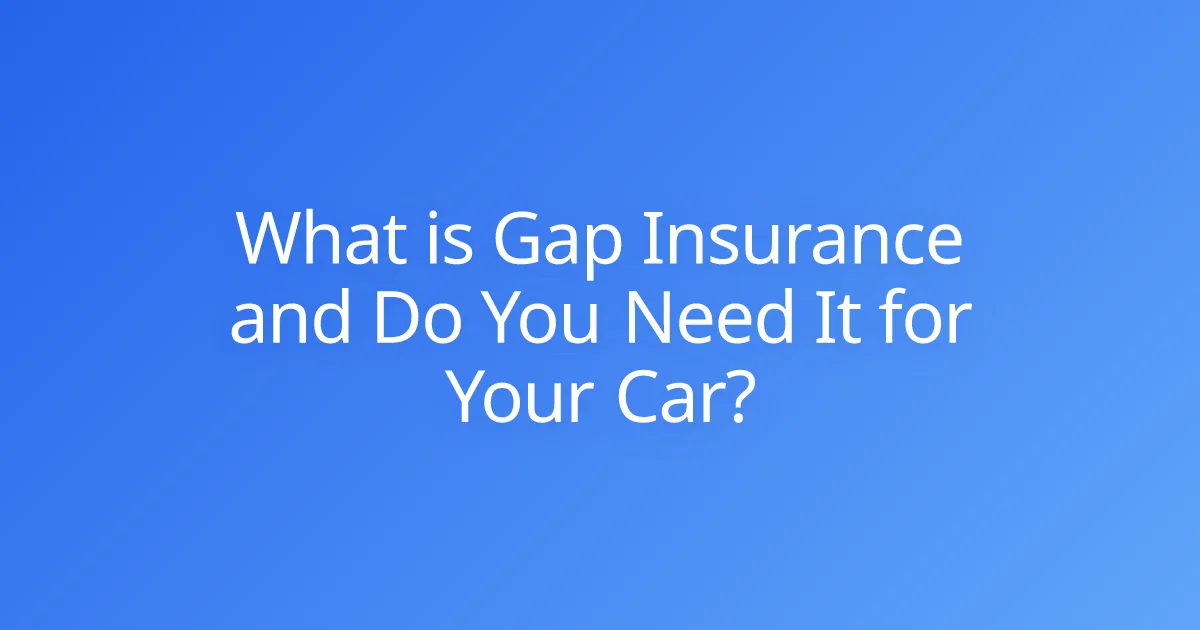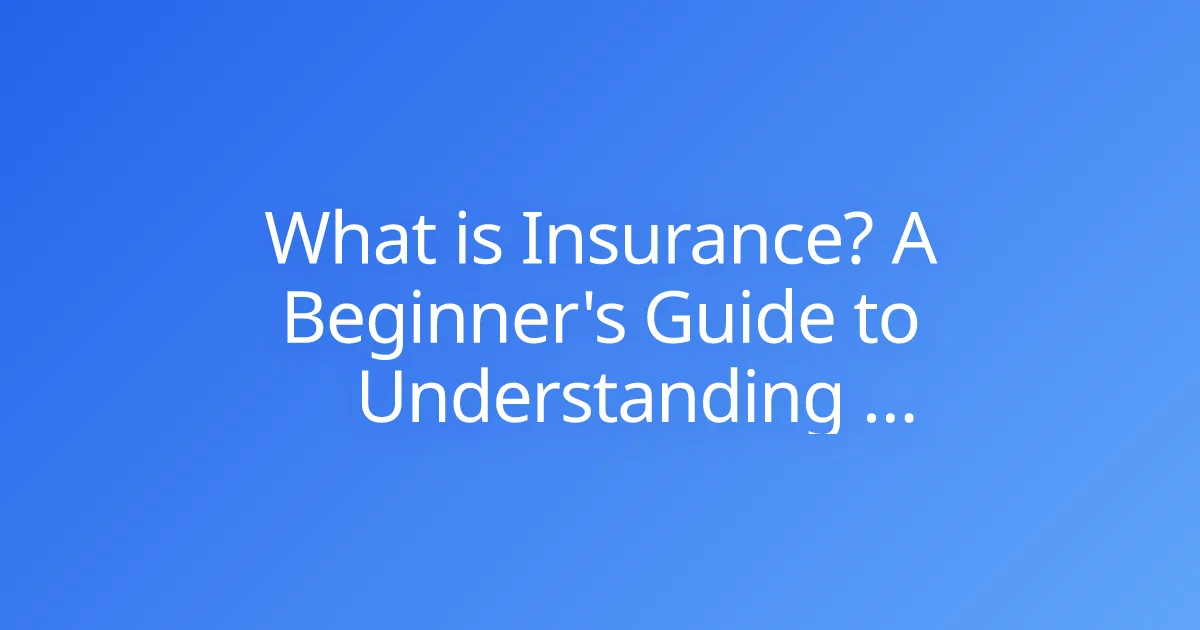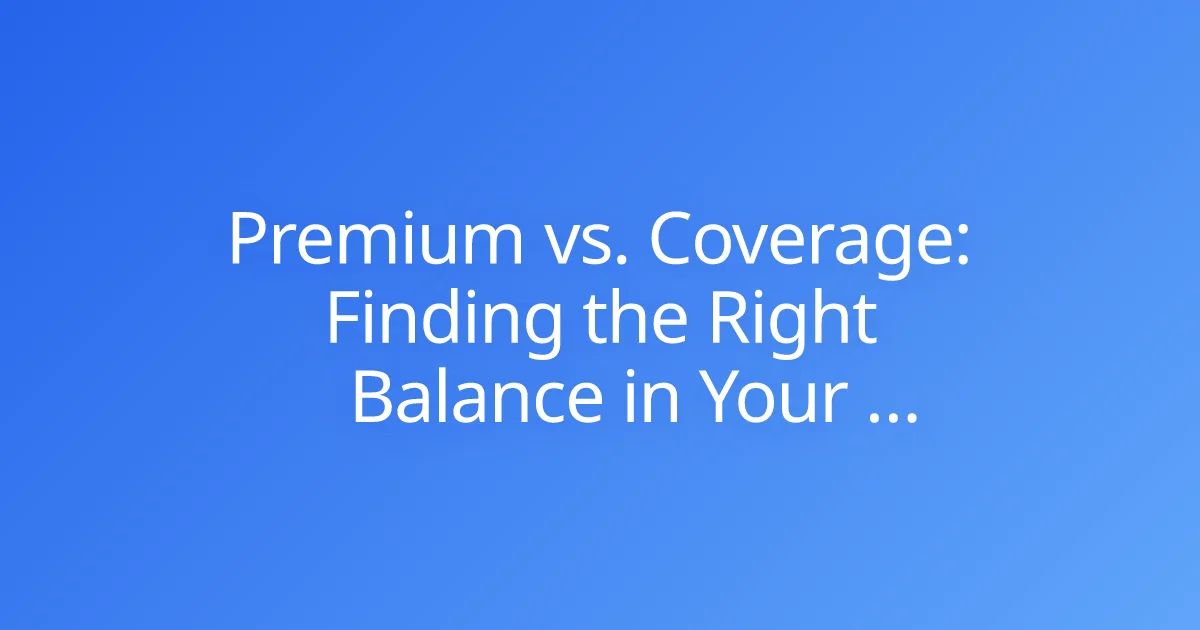What is Gap Insurance and Do You Need It for Your Car?
You’ve just driven your brand-new car off the lot, filled with that new car smell and the excitement of a fresh start. You’ve got your auto insurance in place, covering collision and comprehensive, so you feel completely protected. But what if that new car is totaled in an accident, and your standard auto insurance payout isn't enough to cover what you still owe on your loan? This alarming scenario is more common than you might think, highlighting a critical financial vulnerability that Gap Insurance is designed to address.
At The Policy Explainer, we aim to simplify these complex insurance concepts. This comprehensive guide will demystify what is Gap Insurance, explain how it works, and, most importantly, help you determine if you need it for your car to avoid potentially devastating financial pitfalls. By understanding this often-overlooked coverage, you can ensure your auto loan is truly protected from the moment you drive off the lot.
What is Gap Insurance? The "Gap" Explained
Gap Insurance, short for "Guaranteed Asset Protection" insurance, is an optional auto insurance coverage that pays the difference between the actual cash value (ACV) of your vehicle and the remaining balance on your auto loan or lease, in the event your vehicle is declared a total loss.
The Problem: Depreciation and Loan Balance
The need for Gap Insurance arises from a simple, unavoidable reality: depreciation. New cars begin to lose value the moment they're driven off the dealership lot. This rapid initial depreciation means that for the first few years of ownership, especially with little or no down payment, you might owe more on your car loan than the car is actually worth. This is often referred to as being "upside down" or "underwater" on your loan.
Your standard collision and comprehensive coverage only pays out the vehicle's Actual Cash Value (ACV) at the time of the total loss. It does not consider how much you still owe on your loan.
Example Scenario (The "Gap"):
- You buy a new car for $30,000.
- You make a small down payment or no down payment, financing the full amount.
- After 6 months, the car's Actual Cash Value (ACV) due to depreciation is $24,000.
- You still owe $28,000 on your auto loan.
- Your car is totaled in an accident.
- Your standard auto insurance pays you the ACV: $24,000 (minus your deductible).
- The "Gap": You still owe $28,000 on your loan, but only received $24,000 from your insurer. This leaves you with a $4,000 deficit you must pay out-of-pocket, even though you no longer have the car.
Gap Insurance is designed to cover this $4,000 difference, closing the "gap" between your standard insurance payout and your outstanding loan balance.
How Gap Insurance Works
When you have Gap Insurance and your vehicle is declared a total loss (e.g., stolen and unrecovered, destroyed in a fire, or totaled in an accident), the process generally unfolds as follows:
- File Your Primary Claim: You first file a claim with your standard auto insurance provider (collision or comprehensive).
- ACV Payout Determined: Your primary insurer assesses the damage and determines the Actual Cash Value (ACV) of your vehicle at the time of the loss. They then pay out this ACV, minus your deductible.
- Gap Insurance Kicks In: If the ACV payout from your primary insurer is less than the remaining balance on your auto loan or lease, your Gap Insurance policy activates.
- Covers the Difference: Your Gap insurer then pays the difference between your primary insurer's payout (ACV) and your outstanding loan balance. This payment goes directly to your lender to pay off the remaining debt.
Important Note: Your Gap Insurance payout often also covers your primary policy's deductible, meaning you might get your deductible back as part of the Gap payout. This varies by provider and policy terms, so always confirm.
Do You Need Gap Insurance for Your Car? (Key Indicators)
While Gap Insurance isn't necessary for everyone, it is highly recommended and often crucial in specific situations where the risk of being "upside down" on your loan is high. Consider the following factors:
You Likely NEED Gap Insurance If:
- You Made a Small (or No) Down Payment: If your down payment was less than 20% of the vehicle's purchase price, you'll likely owe more than the car is worth very quickly.
- You Have a Long Loan Term: Loans stretching 60 months (5 years) or more increase the time your loan balance stays ahead of the vehicle's depreciating value.
- You Leased Your Vehicle: Gap insurance is almost always required for leased vehicles, as the leasing company wants to ensure they are fully compensated if the car is totaled.
- You Purchased a Rapidly Depreciating Vehicle: Some car models lose value faster than others. Research common depreciation rates for the specific make and model you're buying.
- You Rolled Over Negative Equity: If you traded in an old car on which you still owed money (negative equity) and rolled that balance into your new car loan, you immediately start "upside down." Gap insurance is vital in this scenario.
- You Financed Extras: If your loan includes additional costs like extended warranties, service contracts, or taxes that inflate the loan amount beyond the vehicle's market value.
You Might NOT Need Gap Insurance If:
- You Paid Cash for Your Car: No loan, no gap!
- You Made a Large Down Payment: If your down payment was 20% or more, you're less likely to go "underwater" on your loan.
- You Have an Older, Paid-Off Car: If your car is older and fully owned, its value might be well below what you'd pay for a new one, but you have no loan to worry about.
- Your Loan Balance is Significantly Less Than Your Car's Value: As your car ages and you pay down your loan, the "gap" naturally shrinks and eventually disappears. You can then drop Gap Insurance.
- Your Primary Insurance Offers a "New Car Replacement" Option: Some insurers offer an endorsement that pays to replace your new car with a brand-new one (not just ACV) if it's totaled within the first year or two. This can make Gap Insurance redundant for that initial period.
Pros and Cons of Gap Insurance
Like any insurance product, Gap Insurance comes with its own set of advantages and disadvantages.
Pros of Gap Insurance
- Avoid Out-of-Pocket Debt: The primary benefit is preventing you from owing money on a car you no longer own, avoiding a significant financial burden.
- Peace of Mind: Knowing you're protected against this "gap" can reduce financial stress related to your car loan.
- Relatively Low Cost: Gap insurance is typically inexpensive, often just a few dollars a month added to your premium.
- Protects Your Credit: By ensuring your loan is paid off, it prevents you from defaulting on a loan for a non-existent asset, which would severely damage your credit score.
Cons of Gap Insurance
- Limited Applicability: Only necessary for financed or leased vehicles, and only during the period when the loan balance exceeds the ACV.
- Not Always Needed Long-Term: As you pay down your loan, the "gap" will eventually close, and the coverage becomes unnecessary. You need to remember to cancel it.
- Can Be Pricier from Dealerships: While convenient, purchasing Gap Insurance from a car dealership might be more expensive than adding it through your primary auto insurer.
- Duplicate Coverage: If your primary auto insurance offers a "new car replacement" option, you might be paying for overlapping coverage.
Where to Buy Gap Insurance
You typically have a few options for purchasing Gap Insurance:
- Your Auto Insurance Provider: This is often the most cost-effective way to get Gap Insurance. Many major insurers offer it as an add-on to your standard policy.
- Car Dealership: Convenient, as it can be rolled into your car loan. However, it may be more expensive and you'll pay interest on the Gap Insurance premium if financed.
- Banks or Credit Unions: Some lenders offer Gap waivers or insurance products directly.
Recommendation: Always check with your primary auto insurance provider first, as they often offer the best rates and integrate it seamlessly with your existing policy. Compare costs from all sources.
Conclusion
Gap Insurance is not just an extra add-on; for many drivers, it's a crucial layer of financial protection that prevents the devastating scenario of being "underwater" on a car loan after a total loss. By understanding what is Gap Insurance, recognizing the indicators for when you need it for your car (such as a small down payment, long loan term, or a rapidly depreciating vehicle), you can make an informed decision that safeguards your financial well-being.
Don't let the silent threat of depreciation leave you with a debt for a vehicle you no longer own. Proactively assessing your needs and securing the right coverage ensures that your excitement for your car isn't overshadowed by unexpected financial burdens. Do you have more questions about how Gap Insurance applies to your specific car loan, or need help comparing options?



